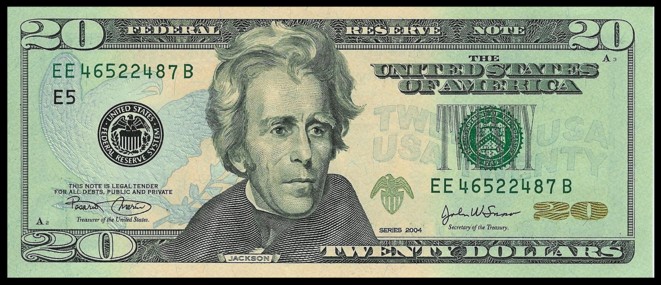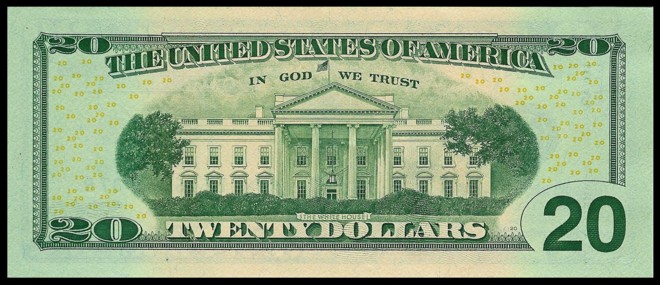1914 Twenty Dollars Federal Reserve Note
In 1914 the notes were bigger than today, and there was a lot of modernization going on everywhere, especially in the field of transportation. The reverse of this 20 Dollar Federal Reserve Note below depicts what were then very modern conveyances: a locomotive, a biplane, an automobile, and a tugboat escorting a massive ocean liner past the Statue of Liberty. Trains and ships were of course the best way to cover long distances then, as the automobile was just a burgeoning market in the United States. The plane was still a long way from being able to carry passengers beyond the pilot and perhaps one other person. The road depicted on the note next to the train appears to be much better than the average road in those days, which were often in deplorable condition: muddy, rutty, bumpy, not paved, un-level, etc., etc.
Note the larger, scalloped blue seal on this FRN; The green seals on FRN’s were not adopted until the series 1928, when all types of notes (FRN’s, USN’s, Silver Cert’s, etc.) adopted standardized colorization for seals and serial numbers, smaller size and other design aspects, including the Federal Reserve seal on the left which would later change from the number-letter combination to the letter only, and today, no number or letter, as seen below. The portrait would also change from Grover Cleveland to Andrew Jackson.


1922 Twenty Dollars Gold Certificate
This note looks as if it’s from another time. It was. Here is a spectacular looking note with a bright Orange reverse. Orange serial numbers and seals on the front also ensured that this note was as good as gold. George Washington sits at center with a beautiful ornate border.
It seems like 1922 shouldn’t be so long ago, but the world has changed considerably since then. In 1922 Then President Warren G. Harding brought the first radio into the White House, women in the USA finally got the right to vote with the passage of the 19th amendment to the Constitution, and Rebecca Felton of Georgia was elected first female US Senator. The first aircraft carrier, the USS Langley, was commissioned – it was a converted collier (coal cargo ship) that was originally named the USS Jupiter. The Lincoln Memorial was dedicated in Washington D.C., and the Hollywood Bowl Amphitheater also opened. And in Egypt, Howard Carter discovered Tutankhamen’s tomb, filled with lot’s of gold.
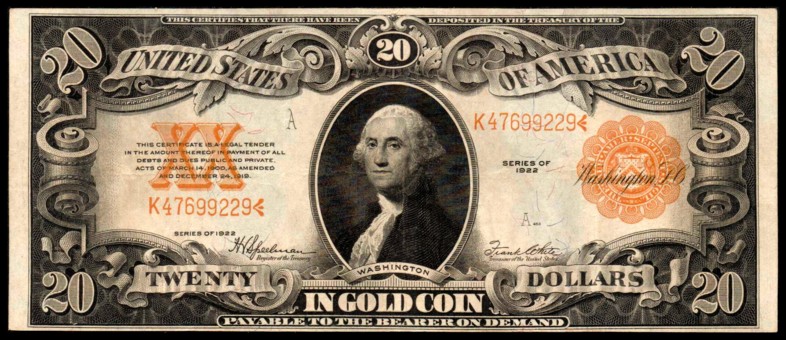
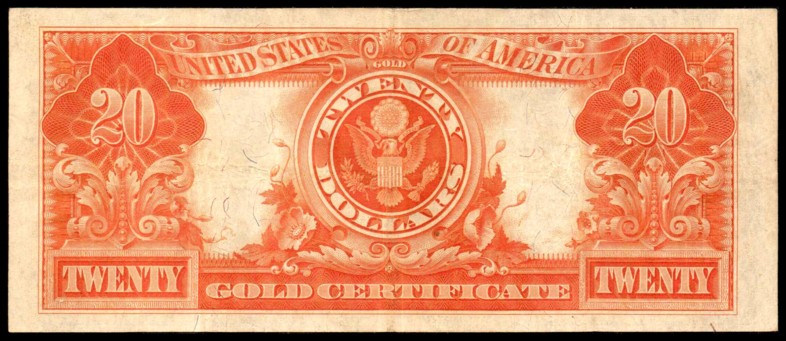
1928 Twenty Dollars Gold Certificate
When the currency was redesigned and resized in 1928, the gold certificates suffered the loss of their bright reverse image, but retained the color for the serial number and the seal. The references to these 1928 Gold Certificates is made only on the front. The reverses of these notes are identical in design to the Federal Reserve Notes.
The series 1928 small sized gold certificate shown above was rather short lived, as it was subject to the Gold Reserve Act of 1934 which stated that all United States citizens were required to turn in their gold as well as their gold certificates to the treasury, which exchanged the gold and the certificates for other types of currency. Exceptions were made for some jewelry and collector coins. Wisely, not everyone did so, and we have a large number of these notes to collect, though they are rather expensive, especially in uncirculated conditions. The gold certificates were released back to the public again in 1964 and are still considered legal tender, but their redemption clause was rendered invalid just like the silver certificates. It sounds strange now, but it was a criminal offense for US citizens to have or trade gold until 1975.
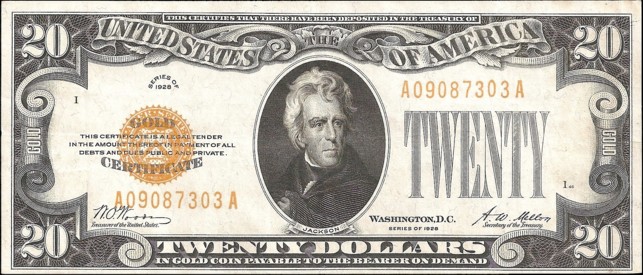
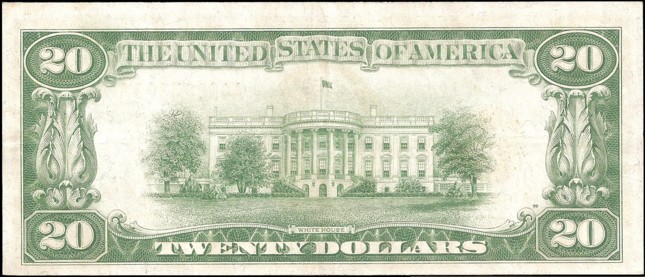
1928 Twenty Dollars Federal Reserve Note “Numerical District”
Up next is a 1928 Federal Reserve 20 Dollar note. The Treasury Seal on the right is green like our modern notes, and the Federal Reserve seal has a number instead of a letter designation. These numbers were printed on the 1928 and 1928A series of notes only. With 1928B series they went to the lettered designation, so this number, 4, would later become D which is, as written on the bottom of the seal, the Cleveland, Ohio branch of the Federal Reserve Bank.
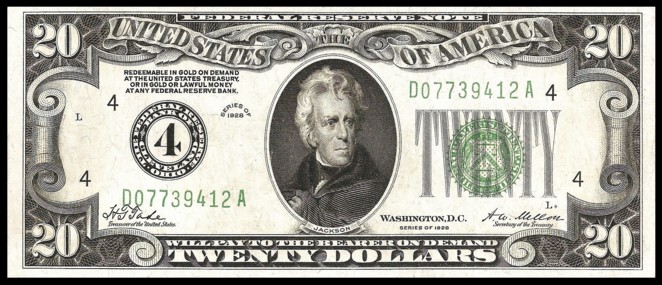

1929 Twenty Dollars National Currency Note “Spokane”
Here is the 1929 issue of a National Banknote. National Banknotes were first brought about in 1863 and effectively replaced the unstable ‘Private’ banknotes, (aka Broken Banknotes) when the National Currency Act authorized banks with $50,000 in capital to become a ‘National Bank’. In addition, a safeguard to stop the banks from going broke was instituted; they had to deposit one-third of their assets in bonds with the US Treasury. Once done, the banks then could issue National Currency with their banks name on it as well as the city and state that branch was in. When the US decided to create smaller currency, the National Banknotes adopted the brown seal and serial number scheme and followed a standard design to fall into a more cohesive look for US Currency. Notice that the Bank and Location are stamped on the left side of the portrait. There are four signatures on this note. The top two are the Register of the Treasury and the Secretary of the Treasury. The bottom two are the local Bank Officers signatures. These banknotes were backed by bonds the banks deposited, which is noted under the National Currency at the top of the banknote. The bold numbers on the left and right are the National Banks Charter Numbers. National Banknotes were discontinued in 1935 when they were slowly removed from circulation.
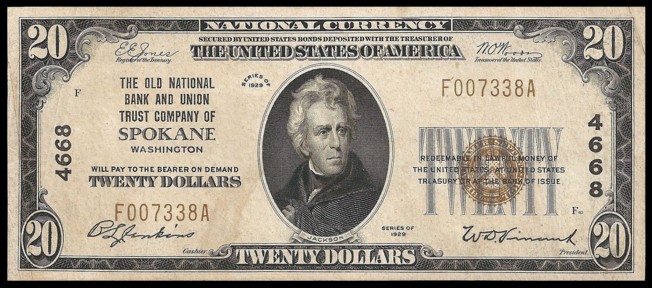

1929 Twenty Dollars Federal Reserve Bank Note
In the first months of 1933, there was a heavy withdrawal from the Federal Reserve in part due to people holding onto their money personally because many banks were failing. National Banks could not issue more currency, due to limitations based on their holdings to issued notes ratio. This resulted in a shortage of available Federal Reserve banknotes for the public. So on March 09, 1933 Federal Reserve Banknotes (FRBN’s) were authorized as an emergency currency to be issued to overcome this shortage of cash.
These emergency notes were printed on unused National Banknotes. There are some obvious differences though, including the overstamp of the bank and location, which was replaced by the Federal Reserve Bank for the district. Instead of leaving the two bottom signatures blank, they Federal Reserve Bank officers signed there (note the two blacked out National Bank titles replaced with appropriate Federal Reserve Bank titles). Similar to the National Banknotes, these Federal Reserve Banknotes were backed by the Federal Reserve Bank, but with an important distinction. While National Banknotes were backed by bonds from the National Banks, these FRBN’s had the added clause of “Or Like Deposit Of Other Securities” added to conform to actual backing practices for these notes. The Charter Numbers were replaced by the letter designation for the Federal Reserve Bank Branch (A=1=Boston, 8=H=St. Louis, etc.). After two years in service, these notes were removed from circulation by the banks.
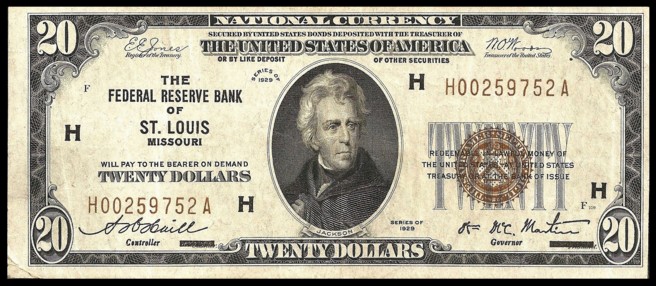

1934 Twenty Dollars Federal Reserve Note “Hawaii”
In Hawaii, it was thought that the Japanese might try to invade the Hawaiian Islands, and as a precautionary measure, the government issued notes specifically for this island chain. Federal Reserve notes were stamped with HAWAII on the left and right of the fronts and a larger stamp on the reverse (the One Dollar bill was a Silver Certificate, as no $1 FRN’s were printed at that time). As a further precautionary measure, the Treasury seal and serial numbers of the notes were colored brown. If the Japanese had invaded Hawaii, the US Government would have been able to easily decree that the Hawaii stamped notes were no longer Legal Tender. These notes were brought home and are still legal tender today, as all government notes are.
The Twenty Dollar Note was the highest denomination to have the Hawaii Overstamp.


1950A Twenty Dollars Federal Reserve Note
Then there’s the Federal Reserve Banknote issue. Remember, these $20 all could have been circulating at the same time! While it is unlikely that this particular note below would have met the above, this basic design was issued from 1928 on. This design stayed on until the change to the large headed notes in 1996.
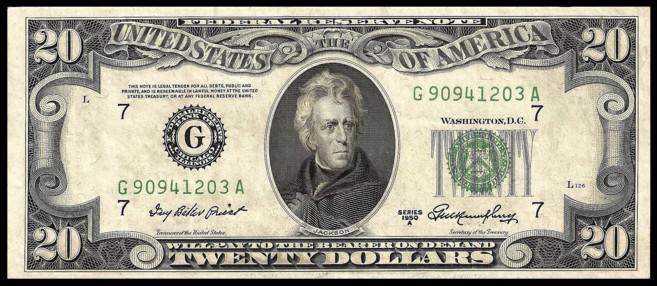
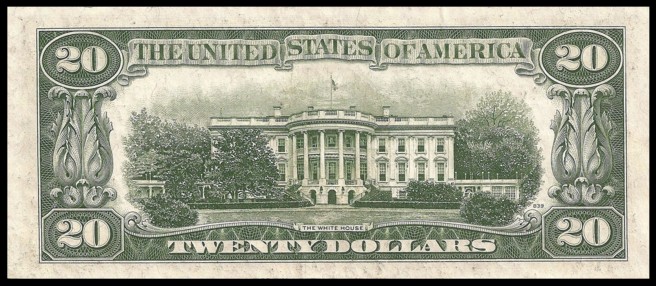
1999 Twenty Dollars Federal Reserve Note “Big Head”
In 1996 the twenty dollar bill was redesigned into this “Big Head” style. A new portrait engraving was nice, but the oval frame view carried over from the previous design and made the whole thing look off balance. On the reverse the depiction of the white house changed from the South Facade to the North Portico. This design was in production for only seven years. To thwart counterfeiters, a watermark, new security thread and microprint were placed into the design as well.


2004 Twenty Dollars Federal Reserve Note “Colorized”
Today’s $20 bill’s design is drastically different than the ones above. Many overt and subtle changes were made, making it much harder for counterfeiters. The Big Head still remains and, without the oval frame, looks much more modern and less lopsided.
